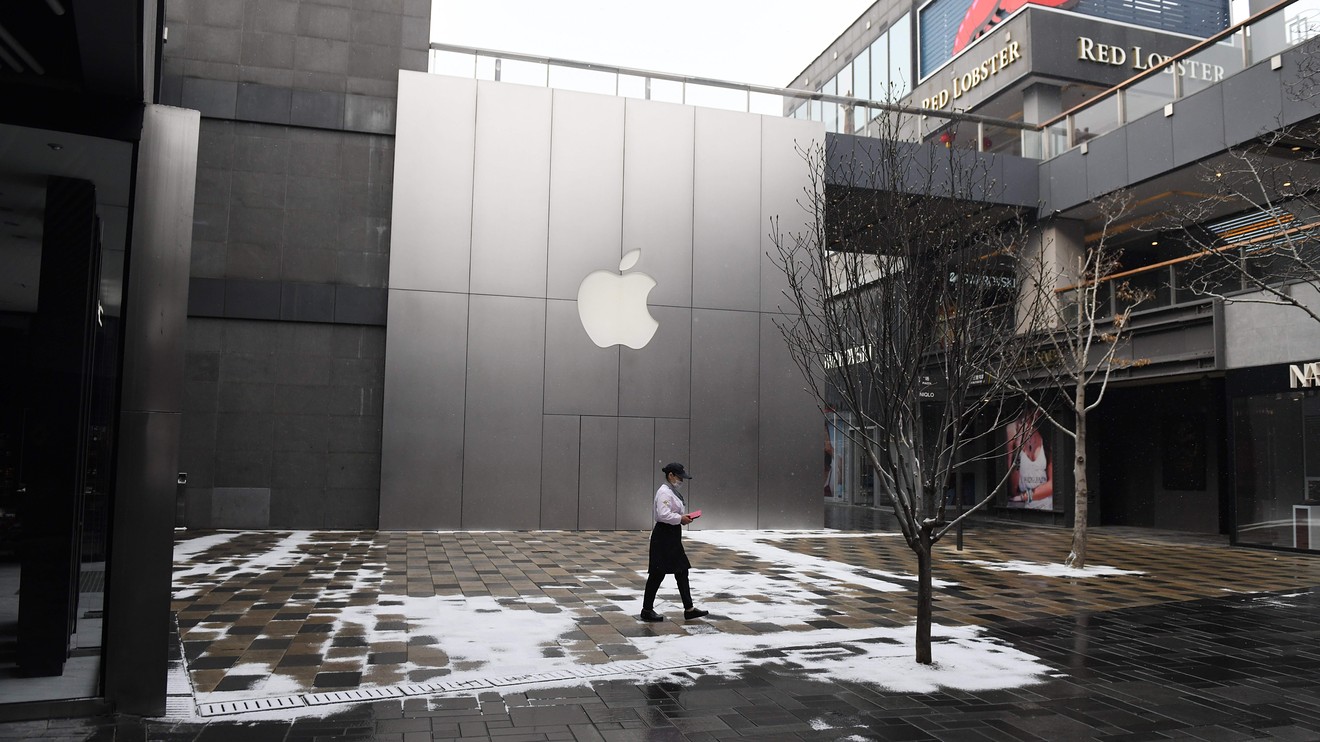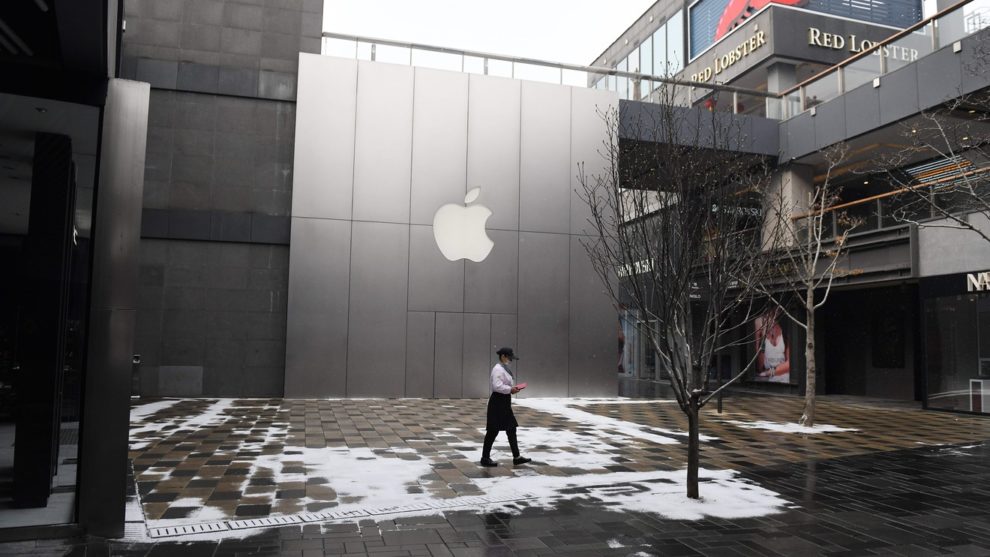
U.S. stocks were mixed late Tuesday after Apple Inc. said that the viral outbreak in China would hurt its second-quarter results, reigniting fears that the disease may disrupt manufacturing supply chains and have broad implications for the global economy and financial markets.
How are the benchmarks performing?
The Dow Jones Industrial Average DJIA, -0.56% traded about 150 points, 0.5%, lower, near 29,246, while the S&P 500 SPX, -0.28% lost 7 points or 0.2% to trade near 3,372. The Nasdaq Composite Index COMP, +0.03% added 6 points, or less than 0.1%, to trade near 9,737, after flipping positive in afternoon trade. Most of the Dow’s decline was attributed to downward pressure in shares of Apple and Dow Inc. DOW, -1.90%, according to Automated Insights. U.S. financial markets were closed Monday for the Presidents Day holiday.
The Dow on Friday booked a weekly gain of 1%, the S&P 500 finished the period with a gain 1.5%, while the Nasdaq Composite Index returned 2.2% for the week.
What’s driving the market?
Apple AAPL, -1.81% said Monday it won’t meet its second-quarter financial guidance because the coronavirus outbreak that originated in Hubei province in China last year is affecting its suppliers’ production. “The health and well-being of every person who helps make these products possible is our paramount priority, and we are working in close consultation with our suppliers and public health experts as this ramp continues,” the iPhone maker said in a statement.
Apple said revenue in the current quarter won’t reach its target range of between $63 billion and $67 billion due to the impact of the infectious disease.
Read: Apple’s coronavirus warning wasn’t a total surprise, but magnitude rattles Wall Street
The COVID-19 epidemic has sickened more than 73,000 people and claimed nearly 1,900 lives thus far.
U.S. markets, which have been primarily focused on corporate earnings and otherwise healthy economic data, have effectively shaken off worries fueled by the disease, but some strategists warn investors may be too dismissive.
“We haven’t really heard of any peak levels, that’s what’s beginning to sink into investors’ minds,” Peter Cardillo, chief market strategist at Spartan Capital Securities in New York, said referring to the rising number of people infected with the coronavirus.
“Also, we have gold prices soaring today,” he told MarketWatch, adding that precious metal could ascend even higher than $1,600 an ounce. “There are a lot of uncertainties and those uncertainties are weighing on the market.”
Read: Why gold prices topped $1,600 and may soon hit a more than 7-year high
“You’re trying to take the information from Apple and extrapolate that to the holdings you actually own,” Robert Pavlik, chief investment strategist at SlateStone Wealth told MarketWatch. “Obviously, there was going to be some impacts,” he said, pointing to disrupted supply chains and weaker demand. “But you just don’t know if the impacts are going to be temporary or if you’re going to lose those orders all together.”
Still, in the year to date, the Dow is up 2.5%, the S&P 500 has gained 4.4%, and the Nasdaq is 8.6% higher.
See: What Apple, Walmart and other U.S. companies are saying about the coronavirus
What’s more, the expected hit to U.S. manufacturing from the coronvirus has not been felt yet: a reading on manufacturing conditions in the New York area surged to a nine-month high in February, the Federal Reserve Bank of New York said Tuesday. The forward-looking new orders component of the index hit its highest in a year.
A closely watched reading about home builder confidence was also strong in February. The National Association of Home Builders’ monthly index hit 74, down one tick from January, but still marking the strongest start to a year on record. The sentiment tracker is considered an early read on the pace of new residential construction.
But the outlook for the embattled energy sector looks tougher. Dallas Federal Reserve President Robert Kaplan said Tuesday he expects this year to see “belt-tightening” and restructurings for companies in the U.S. oil and gas sector as domestic production growth is expected to decline.
Which stocks are in focus?
- Bed Bath & Beyond Inc. stock BBBY, +5.14% rose 4.1% Tuesday after the home goods retailer announced that it would sell PersonalizationMall.com to 1-800-Flowers.com.
- Shares of General Electric Co. GE, -0.74% ticked down Tuesday after The Wall Street Journal reported that the Trump administration may stop it from selling jet engines to China.
- Walmart WMT, +1.54% reported a rise in fourth-quarter net income as the retailing giant issued guidance that didn’t meet analyst estimates. The stock rose 1.7%.
- Medtronic’s stock MDT, -3.67% fell after profit beat expectations but sales came up shy.
- Advance Auto Parts stock AAP, +6.55% rallied after profit beat expectations, but same-store sales disappointed.
- Fluor Corp. FLR, -23.23% said regulators are investigating its accounting and that its filings would be delayed. Shares lost about one-quarter of their value.
- Franklin Resources BEN, +7.49%, the holding company for Franklin Templeton, said it is buying Legg Mason LM, +24.17% for $50 a share. Legg Mason shares were 23.8% higher.
- Tesla Inc. TSLA, +6.81% shares roared 7% higher after Bernstein analysts more than doubled their price target, to $730. The stock was trading more than $100 higher than that.
- Macy’s Inc. M, -3.60% shares declined 3.6% after S&P Global Ratings cut the department store chain’s credit to “junk” status, following the release of the retailer’s three-year strategic plan.
- Shares of Conagra Brands, Inc. CAG, -5.61% fell 5.6% after the packaged-food giant cut its financial guidance, citing softness in consumption.
How are other assets performing?
The price of a barrel of West Texas Intermediate crude for March delivery CLH20, +0.12% settled unchanged at $52.05 a barrel on the New York Mercantile Exchange, after gaining 3% last week.
Gold for April delivery GCJ20, +1.17% rose 1.1% to settle at $1,603.60 an ounce, its highest finish since March 2013, as investors flocked to haven assets.
The U.S. dollar DXY, +0.46% was 0.4% higher against a basket of rival currencies at 99.40.
The benchmark U.S. 10-year Treasury note TMUBMUSD10Y, -2.15% shed 3.3 basis points to 1.554%. The 30-year bond broke below 2%, a key psychological threshold. Bond yields fall when prices rise.
In Europe, the Stoxx Europe 600 SXXP, -0.38% slipped 0.4%, while the FTSE 100 UKX, -0.69% finished 0.7% lower.
In Asia overnight, the China CSI 300 000300, -0.49% ended 0.5% lower to close at 4.057.51, the Shanghai Composite SHCOMP, +0.05% edged up less than 0.1% at 2,984.97, and the Hang Seng Index HSI, -1.54% closed 1.5% lower at 27,530.20. The Nikkei 225 NIK, -1.40% lost 1.4% to 23,193.80.
div > iframe { width: 100% !important; min-width: 300px; max-width: 800px; } ]]>











Add Comment